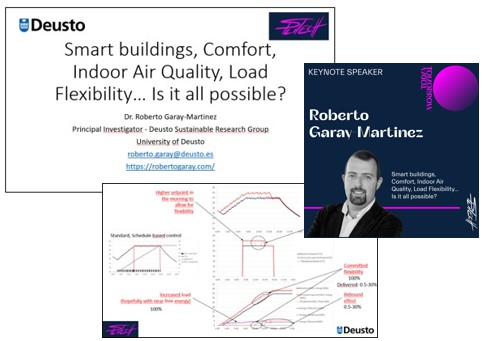A few weeks ago, I was honored with the possibility to deliver a keynote lecture at Splitech. This was my second time attending this great conference, organized by Sandro, Petar and Ana. And they facilitated an empty slot for me to talk.
What is the right topic to talk about in front of an experienced audience on Energy and IT topics? I proposed a quite provocative question: “Smart buildings, Comfort, Indoor Air Quality, Load Flexibility… Is it all possible?” And structured it around two main insights:
- How everything has evolved since I started my career. Energy performance of buildings, the trend towards electrification, etc. And how it impacts the approach required to further improve the performance of buildings.
- What are the missing items in my toolkit to model the transient performance of buildings. I avoided discussing building energy modelling, to focus in these missing items.
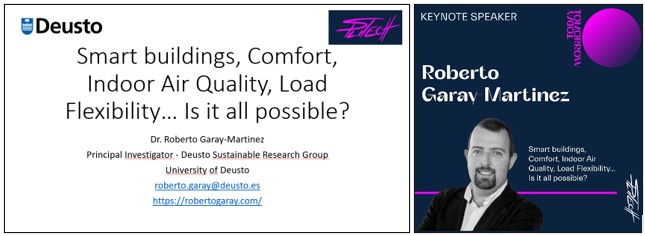
The first bullet point introduce the current situation. And then I introduced the missing items in my modelling toolkit so that “Is it all possible?” can be answered with a “yes”.
So, how have we progressed? All this started for me in 2008, during the adoption of the original EPBD. Since then, energy loads have been substantially reduced (at least in new or retrofitted building), heat pumps are popular, PV is cost competitive, Electric vehicles are being introduced in an accelerated way, and it’s clear that there is some kind of global warning that will most surely increase cooling loads…
Which is the current context? Lower baseloads, greater reliance in electric HVAC, local PV, rollout of Electric Vehicles. We can no longer consider Heating/cooling loads in aggregated whole-year figures. There is a continuous imbalance in the building, where the electric production, storage and loads need to match or be balanced by the electric network.
What is our society asking from buildings? We are no longer happy if a building can better schedule its load for tomorrow. We need more. Buildings are requested to deliver flexibility to the grid. To help make the grid more robust and further rise the share of renewables.
The problem is that buildings are built for shelter, not to balance an electric system. Over time, they have evolved to incorporate some control systems (somewhere from basic thermostats to cutting-edge building management systems). But is balancing the grid just too far? Is it possible to do it (while still being comfortable inside)? That was the question.
If we came all the way from very basic wooden structures several thousand years ago to almost free-shape structures (I really liked this video on the Guggenheim museum, with many pictures taken directly in front of our campus), the answer must be YES (with time and resources).
The actual question for a researcher is slightly different: What is needed to make it possible? Is it already researched? So, I took half of my presentation to identify what are the key missing items for me.
Building energy models are already there. Although it is not fully true, models have been around for many decades:
- Mainstream white box models are almost stable (i.e. Energy plus is currently at version 25)
- Grey box models initiated their path more than 30 years ago. And although there is still a lot of research to do, model identification processes are quite streamlined in recent years. I find many research gaps from my South-European and Engineer perspective, but I will leave this out from this post.
My gaps were more focused on non-engineering problems. That is, those that are more difficult to me to solve (I was kind of asking for help). These are my top 5 problems:
Occupant-focused. This is quite basic: We want to keep occupants comfortable. If there is no-one there, we should not consume energy. There is a need to transition from schedule-based to performance-based control. But this is a little more complex. We should also investigate how to operate buildings so that they come back into the comfort zone as early as one occupant is detected. We need to play with free heating/cooling periods, and setback temperature values that reduce energy consumption while allowing fast transition to comfort zones.
Occupancy and usage models. How can we forecast energy consumption in a building if HVAC is operated based on an occupant-focused approach? The “average” day is no longer valid, we should be able to forecast short-term variations in building occupancy (i.e. through conditional probability & Markov processes). Occupancy is behind many other loads such as plug-loads, lighting, ventilation, etc.
Considering the increasing level of electrification, the key question for many small buildings is no longer “What is the U-value of the windows?” but “Did I use my electric vehicle?” and “What time did I plug-in when coming back home?”.
Probabilistic approach to load optimization. There is a substantial difference between peak shaving/load shifting to delivering flexibility:
- Peak shaving/load shifting is deterministic. With the load profile agreed on the preceding before. Our models support our decision making, given known/forecasted energy cost, and weather conditions (hopefully also, very precise occupancy profiles, etc.).
- Flexibility is NOT deterministic. We are provided with an incentive for our willingness to flexibilize our load. But it is unknown if this flexibilization will actually be executed by the system operator. There is some likelihood in the process.
So, we need to transition into a new type of decision making, where Plan A (no execution), Plan B (full request of flexibility) and any intermediate case result in an acceptable level of service in the building.
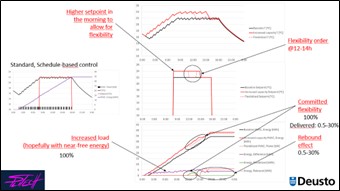
This is quite specific to systems such as buildings that need to guarantee comfort throughout their use. As opposed to Electric Vehicles, etc. where any operation is OK, as long as the vehicle is charged tomorrow at 6AM.
Decision-making processes. We commonly see quite basic approaches when optimizing energy in buildings. Such as “get the lowest possible (non-renewable) energy consumption while keeping the building within a certain temperature band”. Life is a little more complex. If there is a willingness to go for advanced controls (i.e. MPC or Reinforcement Learning), we should consider many other terms in the equation, and code these terms in such a way that no strict limits are imposed.
Also, there is a need to put all the metrics together (Temperature in ºC, Costs in €, Comfort in PMV/PPD,…, IAQ in ppm), this requires weighting (by itself is a “political decision” ), so we need to make a structured approach to reward formulae.
We presented a contribution on this topic to Splitech 2020. At that period, COVID would have made the formulae to prioritize IAQ over other criteria.
Aggregation/Pooling. Although buildings represent a large share of the energy use, individual buildings are not relevant by themselves. And flexibility may not be available at a given time. For this reason, there is a need to research on aggragated/pooled flexibility. We have seen some research on flexibility response functions for buildings, as well as pooled curves for some whiteware. But this research is still at its infancy. This is relevant so that uncertain flexibility at individual building/asset level can be transferred into more certain flexibility at pool level.
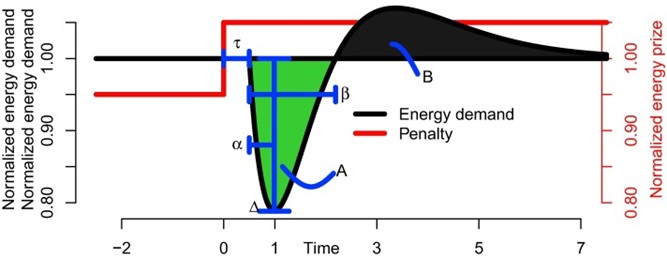
Step response to an energy price signal. Source: Rune Grønborg Junker et Al. CC BY 4.0
It was a pleasure to talk about all this to an interested audience. I´m not an expert at any of these topics, but they are key to deliver accurate models and decision-making processes for short-term operation of building energy systems.
I would be happy to see progress in these topics so that I can make profit from it. If you are working on these topics and willing to collaborate, please contact me. In the meantime, we will be researching on this through the Stunned project.
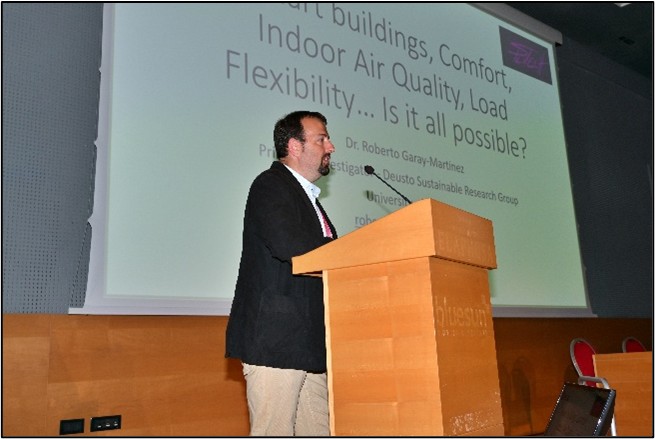
If anyone is interested, the slides are accessible through zenodo: Roberto Garay Martinez, Smart buildings, Comfort, Indoor Air Quality, Load Flexibility… Is it all possible?, 2025 10th International Conference on Smart and Sustainable Technologies (SpliTech), https://doi.org/10.5281/zenodo.15701571
